This post contains affiliate links. If you click through a link I may get a small commision at no expense to you. Read my disclosure policy here.
We tend not to give water much thought. Perhaps because it seems so automatic and neverending. We are truly blessed to have easy access to fresh water all the time.
That’s not true for many people though. Seven U.S. states depend on the Colorado river which provides water for 1 in 10 Americans. Due to overusage, a 20 year drought and climate change, the river no longer reaches the gulf of California in Mexico. Somalia, Egypt, Syria, Pakistan are among the many countries with the very worst clean water shortages. Water wars are the stuff of a great dystopian action film, right? But it’s real life for people in many areas of the world.

So I try to do everything I can to not overburden our water supply. And it doesn’t stink that I cut our water bill in half!
Saving Water in the Garden by Improving the Soil
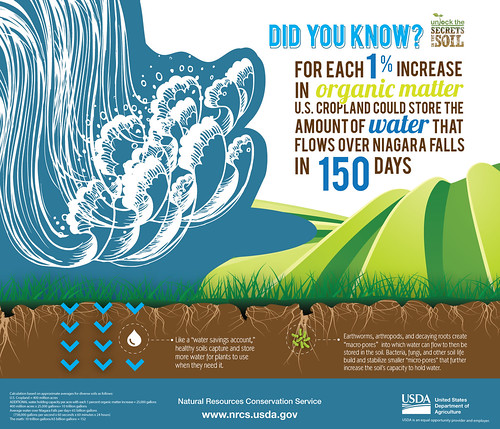
If you garden, whether flowers, vegetables or herbs, you need water. It may come as a surprise, but saving water in the garden begins by adding organic matter. Truly healthy soil with compost, earth worms, healthy microorganisms and strong root systems create pockets that hold water in the soil. Nourishing your soil makes for healthier plants that actually need less watering!
You can benefit your soil before planting by adding compost and after planting by adding mulches such as wood chips, grass clippings or straw. Just be sure these mulches don’t contain pesticides or come from pressure treated wood because you don’t want to harm the beneficial microorganisms in the soil.
Saving Water in the Garden with Rain Barrels
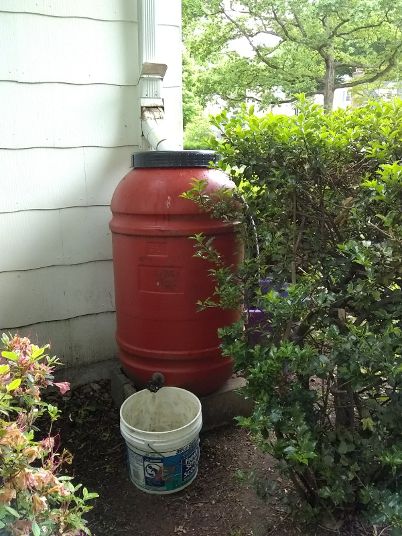
Rain Barrel with Bucket under Nozzle 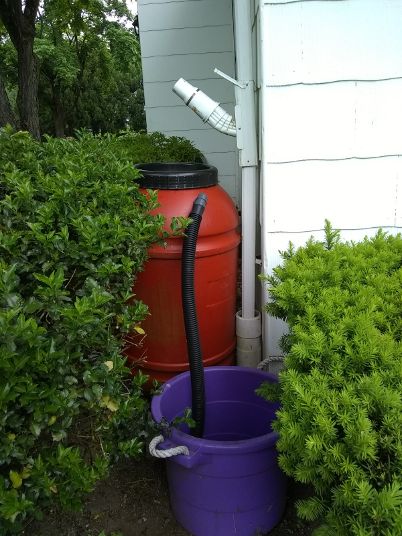
Side view of our front rain barrel and overflow tub. You can see that I lifted the downspout diverter. 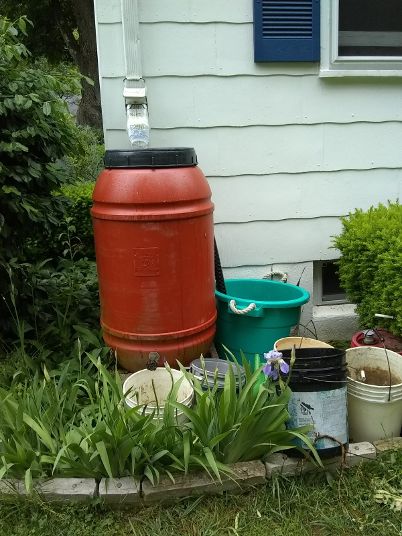
Rain barrel behind our house with large overflow tub and too many buckets.
Another great method for saving water in the garden is to use rain barrels. I wanted a rain barrel for years when we got a notice in the mail (from of all places, our water company!) offering water barrels for sale at a great price. I knew it was the time to jump on the opportunity. We ordered two, one for the front of the house and one for the back. They hold 42 gallons each. Plus our huge overflow buckets can hold up to 15 more gallons each. 112 gallons! And it goes faster than you might expect!
Position your rain barrel by the house to collect all the water that would otherwise run through the gutters and out the downspout to your lawn. The best way to use your harvested rain water is with a hose, so position the barrel uphill from the garden if at all possible. We didn’t have that option and I can tell you that buckets are a distant second method. By putting a smaller, easier to move bucket under the faucet, I can handle pouring the water into larger buckets that my husband is willing to move to the garden for me. I use a small watering can that fits inside the bucket so I can easily refill it.

Overflow buckets are necessary in case your rain barrel gets full. This is to prevent water from collecting against the house in large quantities. Can the overflow buckets overflow? Yes, but in my experience that doesn’t happen often. We also installed downspout diverters which allow us to let the water flow into the rain barrel or not. So if they are all full, we will let the water drain as it normally would. This also allows us to easily return the downspouts to normal used over the winter when we are not using the rain barrels, since the water would freeze.
Where to find Rain Barrels
Home Depot, Walmart, and other big box stores carry rain barrels and any accessories you may need. I saw some good prices on Hayneedle’s website, though I have no personal experience with them
It’s worth searching for special rain barrel programs in your area, perhaps through your utility company or town. I’ve seen a few that offer great discounts. If you have a large barrel already, you can buy a diverter kit to transform it into a rain barrel for about half the cost of buying a new one.
Saving Water in the Garden Based on How and When you Water
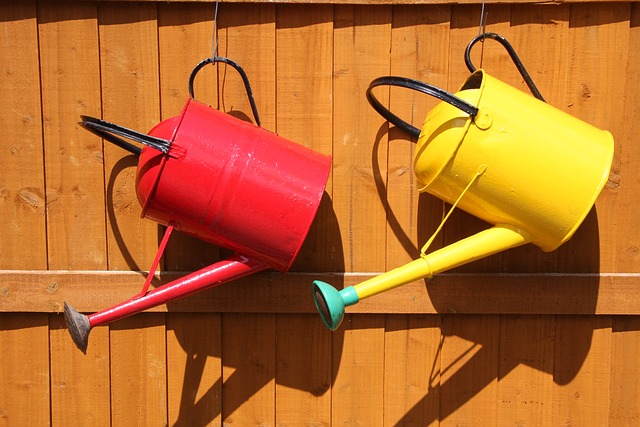
Watering the garden is best done in the morning or evening so that your water will be absorbed and not evaporated. Water the ground around the plants, not the leaves of the plants. Wet leaves can get sunburned and are more likely to develop fungal problems. Water fully and less often. You want the roots to grow deep into the soil so avoid frequent light watering.
Saving Water in the Garden by Capturing Water for Reuse
I also save water from the house. Like most people with a basement, we have a dehumidifier. But unlike many people with a dehumidifier, we don’t have a sump pump. That means we have a bucket of distilled water every day or two. In the winter, it goes in the washing machine. But the rest of the year it goes on my plants.
Our bathroom is old. There’s no nice spin to put on it. Thankfully it’s near the top of our list and likely to get remodeled within a year or so. Anyway, we occasionally have a drip in the tub. I collect that water and use it for the garden too.
The water I use for rinsing vegetables or left over in my water glass usually goes on my houseplants. Somitimes I’ll just pour it right on, but generally I pour dribs and drabs into my watering can so I can do all at once and not forget what already got watered.
I am always looking for ways to tread more lightly on this Earth (carbon footprint and soul), so last year I started pre-rinsing my garden vegetable with a dunk or a scrub (greens vs carrots) in a bucket of the rain water we harvest. That water still gets used for watering and I keep the grit and dirt from root vegetables from messing up my kitchen sink.
Bonus Tip: Another water reuse idea from in the kitchen is to pour boiling hot pasta water on weeds in your driveway. It completely kills them without the need for chemicals or struggling with pulling them.
After our chickens are settled in their coop, we plan to add gutters and a rain barrel to the chicken coop. I can use it at the coop to rinse feed and water pans or anything else that needs cleaning. I hope to use it for the chickens’ water too, but I’m doing my research first to be certain the water will be safe for them.
How are you saving water in the garden? Please share in the comments below. If you’re new to My Frugal Nature, please consider subscribing to my newsletter here.
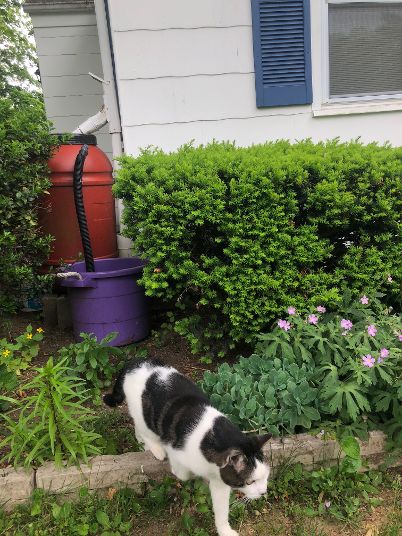
I tried Kerry’s idea of pouring boiling water on the weeds in the driveway and it really works!
Glad to hear it worked for you too, Lynn!
Pingback: Beautiful Bounty: Snow Peas | My Frugal Nature
Pingback: Protecting the Garden from Insect Damage | My Frugal Nature
I always water my gardens in the early morning or the evening as Kerry suggests. An added benefit is that it is cooler for the person doing the watering!
Yes! That is so true!
Pingback: Earth Day Tips on Utilities | My Frugal Nature